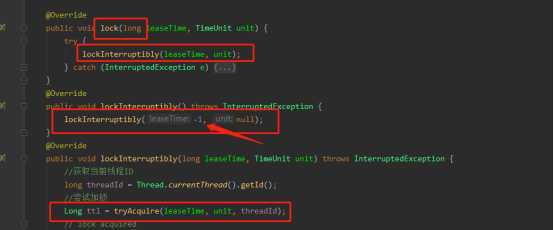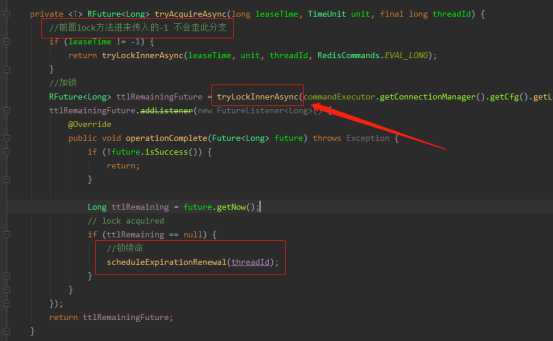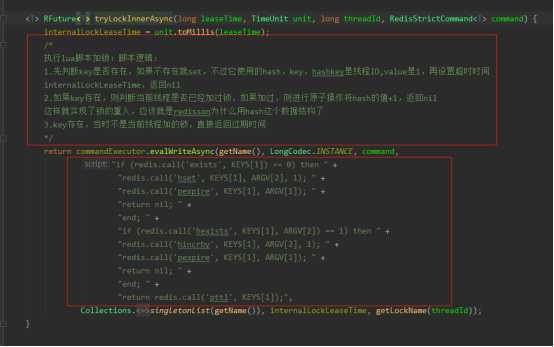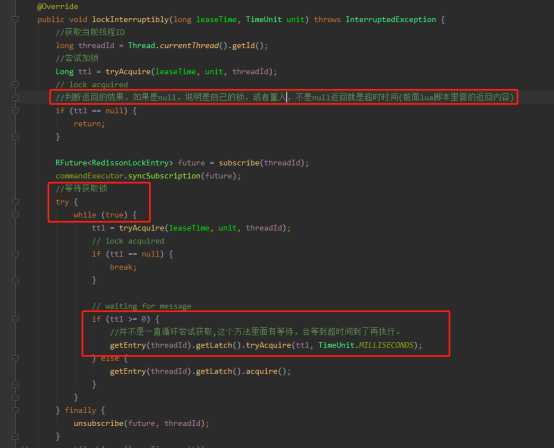当我们在单机情况下,遇到并发问题,可以使用juc包下的lock锁,或者synchronized关键字来加锁。但是这俩都是JVM级别的锁,如果跨了JVM这两个锁就不能控制并发问题了,也就是说在分布式集群环境中,需要寻求其他方法来解决并发问题。前面也说到可以使用redis的setnx操作,如果不存在则set,如果存在则不set。也就是说每个服务实例都对同一个key进行操作。谁能set成功就认为获取到了锁。可以执行下面的操作。执行完之后释放锁。如下按照上述逻辑来简单实现一个分布式锁:
package com.nijunyang.redis.lock; import org.springframework.beans.factory.annotation.Autowired; import org.springframework.data.redis.core.RedisTemplate; import org.springframework.data.redis.core.ValueOperations; import org.springframework.web.bind.annotation.GetMapping; import org.springframework.web.bind.annotation.RestController; /** * Description: * Created by nijunyang on 2020/3/17 23:53 */ @RestController public class LockController { @Autowired ValueOperations<String, Object> valueOperations; @Autowired RedisTemplate<String, Object> redisTemplate; String lock = "lock"; String quantityKey = "quantity"; @GetMapping("/deduct-stock") public String deductStock() { try { boolean getLock = valueOperations.setIfAbsent(lock, 1); if (!getLock) { return "没有获取到锁"; } //使用当做数据库,只是模拟扣减库存场景,因此不使用原子操作 Integer quantity = (Integer) valueOperations.get(quantityKey); if (quantity > 0) { --quantity; valueOperations.set(quantityKey, quantity); System.out.println("扣减库存成功,剩余库存: " + quantity); } else { System.out.println("扣减库存成功,剩余库存: " + quantity); } return "true"; } finally { redisTemplate.delete(lock); } } }
如果不出意外这个锁是可以用的,但是如果拿到锁之后,在执行业务的过程中,服务挂了,就会导致锁没有释放,其他服务永远无法拿到锁,因此我们可以优化一下,加锁的同时给锁设置一个过期时间,这样来保证,拿到锁在执行业务的时候挂了,到了过期时间之后,其他服务一样可以继续获取锁。
package com.nijunyang.redis.lock; import org.springframework.beans.factory.annotation.Autowired; import org.springframework.data.redis.core.RedisTemplate; import org.springframework.data.redis.core.ValueOperations; import org.springframework.web.bind.annotation.GetMapping; import org.springframework.web.bind.annotation.RestController; import java.util.concurrent.TimeUnit; /** * Description: * Created by nijunyang on 2020/3/17 23:53 */ @RestController public class LockController { @Autowired ValueOperations<String, Object> valueOperations; @Autowired RedisTemplate<String, Object> redisTemplate; String lock = "lock"; String quantityKey = "quantity"; @GetMapping("/deduct-stock") public String deductStock() { try { //设置值,并且设置超时时间 boolean getLock = valueOperations.setIfAbsent(lock, 1, 10, TimeUnit.SECONDS); if (!getLock) { return "没有获取到锁"; } //使用当做数据库,只是模拟扣减库存场景,因此不使用原子操作 Integer quantity = (Integer) valueOperations.get(quantityKey); if (quantity > 0) { --quantity; valueOperations.set(quantityKey, quantity); System.out.println("扣减库存成功,剩余库存: " + quantity); } else { System.out.println("扣减库存成功,剩余库存: " + quantity); } return "true"; } finally { redisTemplate.delete(lock); } } }
但是问题又来了,这个超时时间设置多大合适呢,如果网络延迟或者出现了sql的慢查询等,导致业务还没执行完,锁就过期了,这个时候别的服务又拿到了锁,现在并发问题问题又来了。。。A1服务拿到锁,设置过期时间10s,但是业务逻辑需要15s才能执行完,10s过后锁自动释放,这时候A2服务拿到锁执行业务,5s之后A1执行完业务删除锁,但是这个时候A1释放的是A2加的锁,A2这个时候才执行5s,等到A2执行完去释放的又是别的服务拿到的锁,如此恶心循环。。。。
我们可以将锁的value设置成一个客户端的唯一值,比如生成一个UUID,删除的时候判断一下这个值是否是自己生成,这样就可以避免把其他服务加的锁删掉。
package com.nijunyang.redis.lock; import org.springframework.beans.factory.annotation.Autowired; import org.springframework.data.redis.core.RedisTemplate; import org.springframework.data.redis.core.ValueOperations; import org.springframework.web.bind.annotation.GetMapping; import org.springframework.web.bind.annotation.RestController; import java.util.UUID; import java.util.concurrent.TimeUnit; /** * Description: * Created by nijunyang on 2020/3/17 23:53 */ @RestController public class LockController { @Autowired ValueOperations<String, Object> valueOperations; @Autowired RedisTemplate<String, Object> redisTemplate; String lock = "lock"; String quantityKey = "quantity"; @GetMapping("/deduct-stock") public String deductStock() { String uuid = UUID.randomUUID().toString(); try { //设置值,并且设置超时时间 boolean getLock = valueOperations.setIfAbsent(lock, uuid, 10, TimeUnit.SECONDS); // boolean getLock = valueOperations.setIfAbsent(lock, 1); if (!getLock) { return "没有获取到锁"; } //使用当做数据库,只是模拟扣减库存场景,因此不使用原子操作 Integer quantity = (Integer) valueOperations.get(quantityKey); if (quantity > 0) { --quantity; valueOperations.set(quantityKey, quantity); System.out.println("扣减库存成功,剩余库存: " + quantity); } else { System.out.println("扣减库存成功,剩余库存: " + quantity); } return "true"; } finally { //删除之前判断是否是自己加的锁 if (uuid.equals(valueOperations.get(lock))) { redisTemplate.delete(lock); } } } }
这样只是保证自己的锁不被别人删掉,但是这个判断再删除的操作也不是原子操作,同时超时的问题还是没有解决。怎么办呢,我们给锁续命,可以在加锁的同时再起一个定时任务,去检查锁是否释放,如果没有释放就增加超时时间,然后再去定时检查,直到锁被删除了。比如锁超时时间10s,那么定时任务在8s后去检查,锁是否被释放,如果没有释放则重新设置超时时间。继续监视锁是否释放。
如果我们自己按照这个逻辑去实现,有可能还会有很多bug。Redisson已经帮我们很好的实现了分布式锁。配置好之后,使用就像使用java的lock一样。原理就和上述差不多。
加依赖:
<dependency>
<groupId>org.redisson</groupId>
<artifactId>redisson</artifactId>
<version>3.6.5</version>
</dependency>
写配置:
@Bean public Redisson redisson() { Config config = new Config(); config.useSingleServer().setAddress("redis://127.0.0.1:6379").setPassword("xxx"); /** * 哨兵 */ //config.useSentinelServers().addSentinelAddress(""); /** * 集群 */ //config.useClusterServers().addNodeAddress("redis://111.229.53.45:6379"); return (Redisson) Redisson.create(config); }
使用:
package com.nijunyang.redis.lock; import org.redisson.Redisson; import org.redisson.api.RLock; import org.springframework.beans.factory.annotation.Autowired; import org.springframework.data.redis.core.RedisTemplate; import org.springframework.data.redis.core.ValueOperations; import org.springframework.web.bind.annotation.GetMapping; import org.springframework.web.bind.annotation.RestController; import java.util.UUID; import java.util.concurrent.TimeUnit; /** * Description: * Created by nijunyang on 2020/3/17 23:53 */ @RestController public class LockController { @Autowired ValueOperations<String, Object> valueOperations; @Autowired RedisTemplate<String, Object> redisTemplate; @Autowired Redisson redisson; String lockKey = "lockKey"; String quantityKey = "quantity"; @GetMapping("/deduct-stock2") public String deductStock2() { RLock redissonLock = redisson.getLock(lockKey); try { redissonLock.lock(); //使用当做数据库,只是模拟扣减库存场景,因此不使用原子操作 Integer quantity = (Integer) valueOperations.get(quantityKey); if (quantity > 0) { --quantity; valueOperations.set(quantityKey, quantity); System.out.println("扣减库存成功,剩余库存: " + quantity); return "true"; } else { System.out.println("扣减库存成功,剩余库存: " + quantity); return "false"; } } finally { redissonLock.unlock(); } } }
和JUC包里面Lock锁的使用一模一样,有木有?
Redisson锁源码逻辑简要分析,直接在代码中加的注释说明,里面大量使用lua脚本来封装redis操作的原子性,上面提到的判断再删除的操作,也可以写成lua脚本执行,保证原子性。同时lua脚本中如果出错了,数据还会回滚。




虽然看起来已经很完善了,但是还有一点点问题如果哨兵模式,或者集群模式,锁加载master上面,还未同步到slave的时候,master挂了,这个重新选举,新的master上面是没有加锁的。不过这种几率已经很小很小了,如果是在要求强一致性,那么就只有选择zookeeper来实现,因为zookeeper是强一致性的,它是多数节点数据都同步好了才返回。Master挂了,选举也是在数据一致的节点中,因此重新选上来leader肯定是有锁的。当然ZK的性能肯定就没有redis的高了,怎么选择还是看自己业务是否允许。
Redisson也提供了一个RedissonRedLock,传入多个锁对象,加锁的时候,多个锁都加上才认为加锁成功。但是这样需要连接多个redis。这样肯定是有性能问题的,还有网络问题等等。
浅析Redis分布式锁---从自己实现到Redisson的实现
原文:https://www.cnblogs.com/nijunyang/p/12527341.html